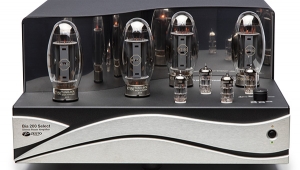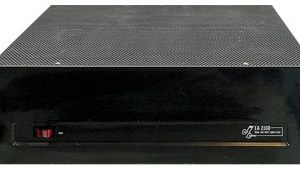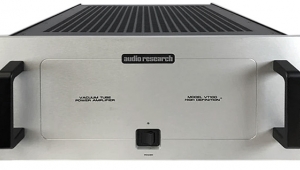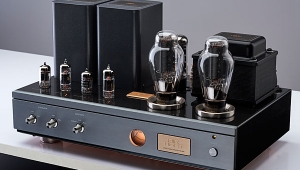| Columns Retired Columns & Blogs |
Nobis Cantabile power amplifier
I dig tube amps. When all's said and done, good tube amps seem to sound more like real life than most solid-state gear; even after listening to and enjoying the hell out of musical solid-state designs like the Audio Research D-240 II and the Muse Model One Hundred, once I hook up the big VTL Deluxe 225s again it's just like going home. I could go on about timbral accuracy and clearer midrange textures, but the bottom line is, music just plain sounds better when you shoot it through good tubes, and once most people experience that magic, they're hooked.
Only problem is, that ol' valve magic don't usually come cheap. Stereophile readers sifting through the various reviewers' reference systems will find Audio Research's $10,000/pair Classic 150s and $3500 Classic 60 pumping out the Vagrants and Vaughan Williams in the homes of J's E and A, respectively; the sumptuous vibrato'd stylings of Lesley Olsher wafting through DO's $6000 Air Tight ATM-2; and VTL's $5000/pair Deluxe 225s teleporting Steve Morse into Bob Harley's listening room and Jimi Hendrix into mine.
I mean, ten grand to play the tube game?! No wonder most real-world audiophiles say, "Make mine silicon!" Most of the tube amps mags like Stereophile cover are megabuck rigs only the rich and plump oppressors of the working class can afford. High-dollar tube rigs are cool man cool, but what I'm after are the affordable stars on the tube scene, amps I can safely recommend to anyone, young or old, looking to get some magic into their homes without putting too much hurt on their Pulse card. In upcoming issues, I'll tackle kilobuck offerings from the best and brightest tube names—Music Reference, VTL, and others. For now, let's see what happens when two companies try re-tooling a classic '50s tube amp for Modern Lovers.
An important message
I'd like to take this opportunity to hereby denounce Albert Goldman's new Elvis: The Last 24 Hours (St. Martin's Press, $3.95). While Goldman's earlier Elvis was an interesting, thought-provoking read, this 189-page paperback is nothing but sensationalistic tabloid-style nonsense. A sample:
"There stood Elvis, looking as though he were playing a scene in a movie. He was wearing a black jumpsuit with a Drug Enforcement Agency patch. Around his waist was one of his gladiator belts, inside which he had stuffed .45s. In his hand he held a Thompson submachine gun, which he had obtained through his friends in the Chicago Mob. David could see the cotton balls soaked with cocaine inside Elvis's nostrils.
"'David!' he shouted. 'Get up! We're goin' headhuntin'!"
I urge you to spend your money instead on I Am Elvis (Pocket Books $8.95), the definitive guide to Elvis impersonators. In addition to features on "Black Elvis" Clearence Giddens and six-year-old "Little Elvis" Miguel Quintana, I Am Elvis lists phone numbers and addresses for each entertainer for wedding, bar mitzvah, and audiophile club bookings. Highly recommended!
Nobis Cantabile: $1700
Nobis is probably a new name to most Stereophile readers, but this Menomonee Falls, Wisconsin manufacturer has offered a full line of attractive speakers and tube electronics for some time now. In addition to their $2200 Proteus preamp, Nobis has their own take on the classic Dyna Stereo 70 called the Cantabile (pronounced "Canta-beel"), an old Wisconsin word for "flowing with melody." But while Panor has generally stuck by the basic Dyna circuit, the Cantabile is a more thorough redesign of the 35W classic; rather than staying with a tubed input/driver stage like the Dynaco 70 II, Nobis designed a discrete-FET stage they describe as being a FET version of the classic Marantz 8B input circuit. This solid-state front-end drives a pair of EL34s per channel in the Ultralinear mode; in fact, Nobis sources the Cantabile's power and output transformers from current Dynaco manufacturer Panor, so these two little tube amps share more than just heritage.
The Cantabile's construction reminds me of the classic Fender guitar amps: rather than sticking a pcb full of parts inside a metal box, the Cantabile's entire circuit is mounted to the metal top-plate, which in turn is fitted into the free-standing wooden cabinet. It wouldn't surprise me at all if someone at Nobis wasn't a guitar-amp tech at some point, but then nothing seems to surprise me anymore except my own growing bitterness at a world gone to hell and the phenomenal success of Home Alone.
I unscrewed the eight screws that held the top plate to the cabinet, and the whole amp lifted out in one piece; the build quality was all aces, with the audio circuit spread out on a central printed circuit board full of metal-film resistors and polypropylene caps. Like the Dyna Stereo 70 II, the Cantabile has a solid-state rectifier, but substitutes two big 1N5408 diodes in a grounded center-tap full-wave configuration for the Dyna's four 1N4006s. The power-supply capacitance is beefier than the Dyna's, at 880µF vs the Dyna's 336µF; in my experience dicking around with tube amps, beefing up the supply capacitance is one of the more worthwhile improvements you can make, and Nobis doesn't kid around here. 880µF is the largest figure I've seen for a tube amp of this size and power rating.
The Cantabile has a similar bias scheme to the new Dyna, but its red LEDs actually extinguish when you set the bias pots just right. However, unlike the teensy, loose-travel trimpots found on the new Dyna, the Nobis has full-sized pots with good, stiff action; once you set these babies, you're through!
If this kilobuck tube shootout were a beauty contest, the Nobis would win hands down. Everything about the amp, from the intelligent input/output connector layout to the high level of fit and finish, suggests a higher standard of appearance than the more utilitarian-looking Stereo 70 II. The Cantabile's beautiful wood-wrapped chassis, in particular, suggests a much higher price tag than $1700; in fact, the Nobis very much appears to be a baby brother to the good-looking $2750 Music Reference MR-9 tube amp DO reviewed three years ago, in Vol.12 No.12.
Sound
The Nobis Cantabile looks like somebody yanked the EL34s and the transformers off a Dynaco Stereo 70 and started over from square one. The looks of the wood-wrapped Cantabile are head and shoulders above the Stereo 70 II, but is the sound?
Yes. In every area of performance, the Nobis came a great deal closer than the 70 II to the standard set by the $5000 VTL Deluxe 225. The new Dyna sounds like a reissue of a vintage classic; the Cantabile sounds like a modern high-end tube amp.
Everything lacking in the new Dyna is there with the Nobis. HF air was greatly increased, giving the sound a much greater sense of real, breathing musicians and instruments in the room. Bass, too, was much improved, but while the Nobis did have a much cleaner and better-defined bottom end than both the Panor amp and my own Dyna, it wasn't exactly the kind of bass that makes grown men cry. Tommy Shannon's bass had better heft on Couldn't Stand the Weather, but it wasn't any kind of rival to the big VTLs. I really don't expect Bass Of The Gods from 35W tube amps, and Nobis hasn't redefined the genre with the Cantabile. Amps like the Nobis and the Dyna are best suited to small, efficient speakers like the Spica TC-50, or the various Signets that have sounded so good at CESes; speakers that can make 35W sound like a million bucks, then roll off in the bass before the tiny tubes get into trouble.
As much as I preferred my vintage 70 to the new Panor, that's how much better the Nobis Cantabile sounded than my own Dyna. The Cantabile's clarity made both Dynas sound old-fashioned and slow. Recorded detail that wasn't even vaguely decoded by the Dynas came through clear as a bell with the Cantabile; the distinction between Lyle Lovett's voice and the slap echo off the wall was there in spades with the Nobis amp. And the attack of the various multitracked acoustic guitars Bob Brozman plays on "La Rosita" off his Hello Central, Give Me Dr. Jazz! Rounder LP came through almost as sharply defined as with the big VTLs, which is no small feat for any tube amp, much less a sub-$2000 from a small-town mob in Wisconsin.
The Nobis is the first hybrid tube/solid-state amp I've heard that doesn't mix the honey of a tube output stage with the rust of a solid-state front end, or the honey of a tube front end with the rust of a solid-state output stage. Listening to the Cantabile, there was no clue that anything but clean tubes were in the signal path. The Cantabile's FET front end has another thing going for it: if you've ever spent time sifting through countless bins of small-signal tubes in the bowels of Surplus Huts, a good-sounding FET front end is just what the doctor ordered.
Nobis has a winner with the little Cantabile. Panor has addressed some of the weaknesses of the classic Dyna circuit, but the new 70 II is still basically an old-fashioned design with the "classic" tube sound. The Cantabile is a modern, audiophile tube amp.
Conclusion
I can recommend the Nobis Cantabile. It may cost $500 more than the new Dyna, but that extra $500 buys you a whole other level of sound quality. I found myself surprised at the fact that I wasn't missing a whole lot while I had the little Cantabile driving the ProAcs, which is high praise indeed considering these speakers are usually mated with the $5000/pair VTL Deluxe 225s.
The Nobis is a legitimate high-end tube amp, offering sound quality on a par with many of the better-known companies on the market. If your listening requirements don't include louder-than-hell levels and bass-bass-bass-all-over-the-place, the Nobis Cantabile deserves a serious audition.
- Log in or register to post comments



































